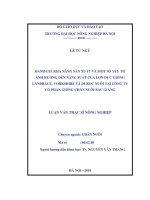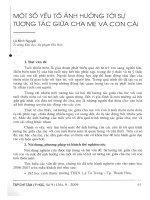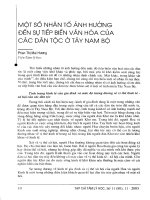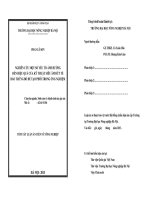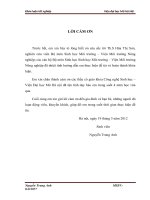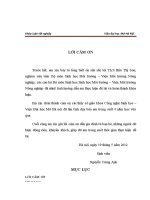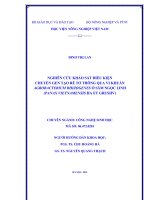Báo cáo một số yếu tố ảnh hưởng đến sinh khối cuả cây sâm ngọc linh (panax vietnamensis ha et grushv ) nuôi cấy in vitro và bước đầu phân tích hàm lượng saponin
Bạn đang xem bản rút gọn của tài liệu. Xem và tải ngay bản đầy đủ của tài liệu tại đây (799.91 KB, 14 trang )
Tgp chi Cdng nghe Sinh hgc 7(3): 357-370, 2009
f i•
.'f('>!::-flb m'im'rrsi;t
THE E F F E C T S O F S O M E F A C T O R S O N IN VITRO
VIETNAMESE
GINSENG
{PANAX
VIETNAMENSIS
PRELIMINARY ANALYSIS OF SAPONIN CONTENT
BIOMASS PRODUCTION OF
HA ET
GRUSHV.)
AND
Duong Tan Nhut', Vu Quoc Luan', Nguyen Van Binh', Pham Thanh Phong', Bui Ngoc Huy', Dang Thi
Ngoc Ha', Phan Quoc Tam', Nguyen Ba Nam', Vu Thi Hien', Bui The Vinh^ Lam Thi My Hang',
Duong Thi Mong Ngoc^, Lam Bich Thao^, Tran Cong Luan^
'lay Nguyen Institute of Biology
^Research Center of Ginseng and Medicinal Materials - Hochiminh City
SUMMARY
"
n
«
*^" '••• • '
'•• •
Panax vietnamensis Ha et Gmshv., a rare Panax genus of Vietnam, is a well known Vietnamese ginseng
(Ngoc Linh Ginseng) for its rich pharmaceutical compositions, most importantly saponin. In order to obtain a
stable and saponin-rich biomass of P. vietnamensis, a tissue culture procedure was established. A TLC analysis
of saponin composition was also conducted to investigate the presence of saponin in callus, shoot and root
biomass. Successful callus induction from leaf and petiole explants was obtained from MS medium
supplemented with 1.0 mg/l 2,4-D (2,4-dichlorophenoxyacetic acid), 0.2 mg/l TDZ (Thidiazuron) under a
photoperiod of 16 h. In the following steps, the optimal auxin and its concenfration, appropriate photoperiod
condition as well as callus size that were the best for callus proliferation were investigated. Among the auxins,
including 2,4-D, IBA (Indole-3-butyric acid) and NAA (a-Naphthaleneacetic acid), 2,4-D at 1.0 mg/l was
found to be the most effective for callus growth. Callus at the size of 0.5 x 0.5 cm grew the best as compared to
bigger ones, such as 0.7 x 0.7 cm and 1.0 x 1.0 cm. The effects of phytohormones, sucrose and activated
charcoal (AC) on shoot regeneration from callus and shoot proliferation have also been studied. Calli cultured
on MS medium supplemented with 1.0 mg/l BA and 1.0 mg/l NAA regenerated more shoots. The suitable
medium for shoot proliferation was MS'/z medium, supplemented with 1.0 mg/l BA, 0.5 mg/l NAA, 50 g/l
sucrose and 2.0 mg/l AC. Callus was grown on MS'/2 medium supplemented with 3.0 mg/l NAA to regenerate
roots. Root proliferation was obtained on MS'A medium containing 5.0 mg/l NAA. In saponin analysis
experiment, thin layer chromatograms show that obtained calli, shoots and roots from the above experiments
had ginsenoside-Rgl and majonoside-R2, two main ginsenosides of Vietnamese Ginseng but only roots have
ginsenoside-Rbl. These results indicate that Vietnamese Ginseng biomass can be used as a new source for
saponin isolation for pharmaceutical and cosmetic industry.
Keywords: Panax vieMamensis, callus, regeneration, shoot, root, saponin
INTRODUCTION
'
'
Ngoc Linh Ginseng, with the scientific name
Panax vietnamensis Ha et Gmshv, is a famous
... ^
^.
.,,
^.,^.
, ,
V.etiiamese Ginseng. Ngoc Linh Gmseng had not
only typical medical effects but also specific
physical actions like anti-stress, anti-depression, in
vitro and in vivo antioxidation, etc. and saponin
triterpenoic compounds are the main effective group.
Ngoc Linh Ginseng possessed the highest
dammaran-frame saponin (12-15%) and saponin
content among Panax genus. With these special
features, this ginseng is one of the most precious
species not only in Vietnam but also the world
,,.
(Dong et al, 2007).
At present, Ngoc Linh Ginseng supply is very
limited because it is grown mainly in Ngoc Linh
mountain area and takes long time to grow. Due to
excessively harvesting, the gingseng is among 250
endangered species, at high risk of extinction
(yietiiam's Red Data book),
Dung (1995) performed some research in order
to improve Ngoc Linh Ginseng culture mediuni. In
2006, Nhut et al. (2006) had some studies on rapid
multiplication of Ngoc Linh Ginseng secondary
roots. Jacques et al. (2007) investigated optimum
conditions to increase ginseng biomass in bioreactor.
Recently, Duong et al. (2008) have initially
performed HPLC in order to quantify ginsenosideRgl, -Rg2, -Rd in cell extract from ginseng biomass.
357
t*0(K, ..QKr.-Xll :{t)T ,v
Apparently, the collection of biomass and
examination of saponin component presented in
collected biomass are essential in considering the
effectiveness of in vitro groivth.
• ; ,: j,,
In the current research, we investigated the
effects of medium compositions, culture conditions,
as well as culture explant's size on in vitro
multiplication of Ngoc Linh Ginseng from callus
induction to root and shoot regeneration stage,
together with qualification of saponin in collected
biomass, therefore initially assess the effectiveness
of in vitro culturing.
MATERIALS AND METHODS
Materials
Explants: leaves and petioles of Ngoc Linh
Ginseng, grown at Tay Nguyen Institute of Biology,
were used as starting material for the induction of
calli. Collected materials were gently washed with
Javel water (Sodium chloride), and continuously
washed with water in 2 hours. Explants were shaken
in 70% alcohol in 30 seconds and continuously
rinsed 4 - 5 times with water, then in 0.1% HgCl2
contained a few drop of Tweens-20 in 5 minutes.
Explants were then washed with distilled water 5 - 6
times. The leaves were cut into pieces with size LOx
10 cm, while the petioles were vertically cleft and
cut into 1.0 cm parts.
Collected calli with different sizes were used for
different subsequent experiments.
Culture medium: MS basal medium (Murashige,
Skoog, 1962), modified 'AMS (originated essential
minerals and half of microminerals) and modified
MS'/2 (half essential and. microminerals) media
supplemented with 30 g/l sucrose, 8.0 g/l agar and
pH 5.7. During examining the effects of sucrose or
active charcoal, the other components' concentration
could be changed depending on experimental
conditions.
Culture conditions: callus induction and
development, shoot regeneration and proliferation
were carried out at average temperature 25 ± 2°C,
lighting intensity 2.500 - 3.000 lux, average
humidity 75 - 80%. To investigate the effects of
lighting condition, explants were culmred and kept
in dark room or lighting room 16 hours/day. Root
regeneration and proliferation experiments were
carried out in the dark.
358
Duong Tan Nhut et al
Experiment designs
Effect of auxin type and concentration on callus
induction from leaf and petiole
Disinfected leaf and petiole explants were
cultured on MS medium supplemented 0.2 mg/l TDZ
and auxins such as 2,4-D, IBA and NAA with
different concentrations (0.5, 1.0, 2.0, 3.0 mg/l).
Effect of lighting condition on callus induction
from leaf and petiole
The most suitable medium for initial callus
formation from leaf and petiole explants was used
for investigating lighting conditions. Explants were
kept in dark room or lighting condition in 16
hours/day.
Effect of auxin types and their concentration on
callus multiplication
Calli formed in induction stage were cultured in
MS medium supplemented 0.2 mg/l TDZ and auxins
such as 2,4-D, IBA and NAA with different
concentiations varied from 0.5; 1.0; 2.0; 3.0; 5.0
mg/l in lighting condition 16 hours/day.
Effect of expiant size on callus development
Calli were sliced (prepared) into 3 sizes: 0.5 x
0.5 cm (KT I); 0.7 x 0.7 cm (KT II) and 1.0 x 1.0 cm
(KT III). Callus slides with specific size were
cultured in optimal medium for multiplication. Calli
after multiplication were used for shoot and
adventitious root regeneration.
Effect ofBA and NAA on shoot regeneration from
Callus derived from rapid multiplication were
collected and subcultured into shoot regenerative
medium supplemented with BA (0.5; 1.0; 2.0; 4.0
mg/l) and NAA (0.5; 1.0; 2.0; 4.0 mg/l). '
Effect ofBA on shoot development
The best shoots from above experiment were
collected and tiansferred into ViMS supplemented
with 1.0 g/l charcoal, 30 g/l sucrose, 0.5 mg/l NAA
and BA (0.5; 1.0; 2.0; 4.0 mg/l).
Effect of sucrose concentration on in vitro shoot
development
The best shoots from callus-derived regeneration
experiment were collected and subcultured in '/2MS
medium supplemented with 0.5 mg/l NAA, 1.0 mg/l
BA, pH = 5.7 and sugar with different concentrations
Tgp chi Cong nghi Sinh hgc 7(3): 357-370, 2009
(10, 20, 30, 40, 50, and 60 g/l).
was then photographed and stored.
Effect of activated charcoal on in vitro shoot
development
Retention factor (Rf) calculation: Rf value and
color visualization with different detection agents
compared with those on color chart were critical
factors to determine the present of saponins in
analyzing solutions. Rf value of compound A is
defined as the distance traveled by compound A (IA)
divided by the distance traveled by the solvent (Io).
The best shoots from callus-derived regeneration
experiment were collected and subcultured in ViMS
medium supplemented with 0.5 mg/l NAA, 1.0 mg/l
BA and pH = 5.7 with different charcoal
concentrations (0, 1.0, 2.0, 3.0, 40 g/l).
Effect of lAA, IBA and NAA on adventitious root
formation from callus
Calli were cultured into root induction medium
contained auxins (NAA, IBA, and lAA) with
different concentrations (1.0, 3.0, 5.0, 7.0 mg/l).
Effect of IBA and NAA on adventitious root
multiplication
Callus-derived adventitious roots were collected
and subcultured into root multiplication medium
supplemented with auxins (NAA and IBA) at
different concentrations (1.0, 3.0, 5.0 mg/l).
Saponin isolation from callus, shoot and root
biomass of Panax vietnamensis by TCL method
Thin layer chromatography was employed in
order to (clarify) qualify saponins with following
steps.
, . , _, .
Solvent preparation: two solvent systems were
used with chemical ratio as followed: Solvent system
1: CHCI3 - MeOH - H2O (65 : 35 : 10, lower layer);
solvent system 2: n-BuOH - AcOH - H2O ( 4 : 1 : 5 ,
upper layer).
Thin layer and sample loading solution
preparation: Silica gel plate (Merck) was prepared
with suitable size. Sample from Namba extraction
method was diluted with several drops of methanol
and loaded to the plate.
Sample loading and color detection: samples
were loaded with same horizontal position and the
bands on a plate were distributed as followed: 1
standard Korean Ginseng, 1 standard Ngoc Linh
Ginseng, 3 standard ginsenosides including
majonoside R2 provided by Ho Chi Minh City
Ginseng and Medical Institute, ginsenoside-Rbl
(Rbl) and ginsenoside-Rgl (Rgl) provided by
Nacalai tesque (Japan); 1 sample (calli, shoots and
roots) and 1 sample contained all 3 above standard
ginsenosides. After miming, the plate was sprayed
with 10% sulfuric acid (H2SO4) in alcohol, dried at
110°C in 5 minutes for color detection. Thin layer
RESULTS AND DISCUSSION
-
-
Effect of auxin types and concentration on callus
induction from leaf and petiole
Research on other species belonging to Panax
genus showed that callus induction stage usually
required the combination between cytokinins and
auxins. In case of Korean Ginseng, if seed is used,
induction medium should be MS supplemented 1.0
mg/l 2,4-D and 0.01 mg/l kinetin (Arya et al, 1993);
if leaf and the other explants are used, induction
medium should be MS supplemented 1.0 mg/l 2,4-D
and 0.1 mg/l kinetin (Lim, Lee, 1997). In callus
induction and multiplication experiments, we used
TDZ as cytokinin with constant concentration (0.2
mg/l) to investigate the effects of auxin types and
concentrations.
Table 1. Effect of auxin types on callus induction from leaf
and petiole.
Auxin
Concentration
(mg/l)
Petiole
Leaf
2,4-D
0.5
100
20
1.0
100
90
2.0
100
90
3.0
100
80
0.5
0
0
1.0
0
0
2.0
0
0
3.0
0
0
0.5
0
0
1.0
0
0
2.0
0
0
3.0
0
0
IBA
N/V\
-
Callus induction (%)
Table 1 shows our records after 8 weeks
cultured. Among 3 auxins added to induction
medium, 2,4-D exhibited the ability to stimulate
359
Duong Tan Nhut et al.
:(^-)t
callus formation fi-om leaf and petiole. In medium
supplemented 1.0 mg/l 2,4-D, cultured explants gave
the highest ratio of callus formation (90% for leaf
explants and 100% for petiole), with a high number
of rigid stmcture and bright yellow calli. At 3.0 mg/l
2,4-D, calli started to form crystalline. According to
Rakhakrishana et al. (2001), the cells can only utilize
a limit amount of auxin and over-use of auxins at
any level can lead to cell development inhibition.
Therefore, above 3.0 mg/l of 2,4-D is not suitable for
callus induction from Ngoc Linh Ginseng leaves.
to stimulate callus formation from Ngoc Lmh
Ginseng leaves similarly to those in dark condition.
Table 2. Effect of lighting condition on callus induction from
leaf and petiole.
2,4-D
(mg/l)
Expiant
0.5
Leaf
Callus induction (%)
Light
(16 hours/day)
Dark
20
30
1.0
90
80
Effect of lighting condition on callus induction
from leaf and petiole
2.0
90
90
3.0
80
80
Depending on explants, lighting can be used or
not during callus induction period. In case of leaf
explants, callus formation is would rather carried out
in the dark. However, in some cases, culture explants
can produce better calli in lighting conditions. Data
in table 2 show that callus formation ratio is almost
the same between leaf and petiole explants either in
dark or lighting condition. Nevertheless, in the dark,
the number and quality of calli are lower than in
lighting condition due to crystalline formation,
especially in medium supplemented with 3.0 mg/l
2,4-D (Fig 1. ai, 32). These results are consistent with
those from Lim and Lee (1997) on Korean Ginseng.
Therefore, the lighting period of 16 hours/day is able
0.5
100
100
Petiole
1.0
100
100
2.0
100
100
3.0
100
100
Effect of auxin type and concentration on callus
multiplication
Table 3 showed that after multiplication stage,
calli cultured in medium supplemented 0.5 mg/l IBA
had the highest dry weight (9.62%)) but highest
increase ratio of dry callus weight was observed at
medium contained 1.0 mg/l 2,4-D.
Table 3. Effect of auxin types on caiius development.
Auxin
2,4-D
IBA
NAA
360
Concentration
(mg/l)
Initial fresh
weight (mg)
Biomass (after 4 weeks culture)
Fresh weight (mg)
Dry weight (mg)
Dry weight (%)
0.5
203 ±16
584 ± 34
43.3 ± 2.5
7.42
1.0
212±14
809 ± 37
66.2 ± 3.0
8.18
2.0
204 ±17
711 ±32
52.4 ± 2.4
7.37
3.0
205 + 9
508 ± 24
36.6 ± 2.2
7.21
5.0
201 ±13
493 ± 38
34.6 ±1.7
7.01
0.5
197 ±18
474 ± 23
45.6 ± 2.2
9.62
1.0
203 ±19
532 ± 29
48.6 ± 2.7
9.14
2.0
207 ±13
631 ± 32
49.5 ± 2.5
7.84
3.0
203 + 15
552 ± 26
41.1 ±1.9
7.45
5.0
209 ±12
531 ± 23
35.3 ±1.5
6.66
0.5
218±8
485 ±13
41.2±1.1
8.49
1.0
212 ±14
548 ± 21
45.0 ±1.8
8.22
2.0
206 ±15
58&±18
46.6 ± 1.4
7.92
3.0
199 ±7
602 ± 32
45.7 ± 2.4
7.60
5.0
205 ±14
720 ± 48
51.6 ±3.4
7.20
Tgp chi Cong nghe Sinh hgc 7(3): 357-370, 2009
Figure 1. Callus formation and multiplication of Ngoc Linh Ginseng. From the left to the right, respectively. ai. callus
formation from leaves on medium containing 0.5; 1.0; 2.0; 3.0 mg/l 2,4-D in lighting condition 16 hours/day; 82. callus
formation from ginseng leaves on medium containing 0.5; 1.0; 2.0; 3.0 mg/l 2,4-D in dark condition. bi. callus multiplication
on medium containing 0.5; 1.0; 2.0; 3.0 mg/l 2,4-D; 62. callus multiplication on medium containing 0.5; 1.0; 2.0; 3.0 and 5.0
mg/l IBA; ba. callus multiplication on medium containing 0.5; 1.0; 2.0; 3.0 and 5.0 mg/l N/\A.
According to Medina et al (1998), carbohydrate
was responsible for most of callus dry weight. The
main carbon source in medium was sucrose, and
sugar utilization of callus depends on types of
medium and sample sources (Medina et al, 1998).
Therefore, probably the utilization of both auxin and
cytokinin could help calli improving their sugar and
other nutrients absorption from culture medium,
which caused the development of callus, especially
dry biomass. According to our results, IBA could be
more effectively used with TDZ, than it did with
NAA and 2,4-D, in order to enhance nutrition
utilization. Dry weight ratio of calli in 0.5 mg/l IBAcontaining medium was highest among 3 tieatments
using 3 auxins (Table 3). Although dry weight of
calli in IBA-containing medium was highest, 2,4-D
offered the highest dry weight increase ratio and
relative high level of weight in calli. Altematively,
361
(.'WZ ,OVf.-tSr :(f;jT
calli had the best conditions and were the highregenerative calli, in 2,4-D-containing medium (Fig.
lb,).
Effect of expiant size on callus development
Expiant size is one of the most critical factors in
in vitro multiplication. The initial difference of
expiant size can lead to a significant difference in
cell density in multiplying process, which causes a
mass change in the other factors in culture medium;
therefore, cell metabolization could be affected
directly or indirectly (Akalezi et al, 1999). When
investigating the effects of initial callus size on
callus development, we learnt that the smallest size
(0.5 X 0.5 cm, KT I) gave the highest increase of
fresh and dry weight, while the remaining size (KT
II, KT III) did not show any difference in
multiplication (Table 4). This increase could be
resulted from the correlation between expiant size nutrition absorption ability and the effects of intemal
waste products from callus development process.
Callus size is related to contact area with the
medium. In the experiment, the area that callus KT I,
KT II and KT III exposed to medium were 0.25, 0.49
and 1.00 cm^, respectively. Nevertheless, as we
Duong Tan Nhut et al
observed, average real contact area between cultured
expiant and medium was calculated as followed:
0.24 cm^ for KT I, 0.40 cm^ for KT II and 0.84 cm^
for KT III. Therefore, contact area ration between
explants was: KT III : KT II : KT I = 3.5 : 1.67 : 1;
while weight ration between explants was KT III :
KT II : KT I = 3.92 : 1.82 : 1. Weight increase ratio
higher than volume ratio would prevent callus from
absorbing nutrients from culture medium, and this
may be one of the main reasons causing lower
development of bigger callus size.
Callus development could release some products
which have toxic feedbacks to calli themselves.
Garcia and Einset (1983) realized that when tobacco
calli were grown in the present of 2,4-D at 0.5 to 25
mg, they could be able to produce higher intemal
ethane and ethylene into the medium, which later
decelerated callus multiplication. There would be the
possibility that with the same 2,4-D concentration,
callus with bigger size could produce more ethylene
and ethane and in tum, these intemal gases caused
toxic and inhibited callus development of Ngoc Linh
Ginseng. And therefore, callus with smaller size
could produce less wasting gases and have higher
rate of development.
Table 4. Effect of expiant size on callus development.
Data collection
KT 1 (0.5 X0.5 cm)
KT II (0.7 X 0.7 cm)
KT III (1.0x1.0 cm)
Initial fresh weight (mg)
147 ±6
267 ±18
576 ± 24
Biomass
after 4
weeks
culture
Expiant size (cm)
1.1 x0,9
1.4 x 1.0
1.6x1.2
Fresh weight (mg)
667 ± 45
804 ± 35
1.505 + 66
Dry weight (mg)
53.9 ± 3.6
57.8 ±2.5
102.8 + 4.5
Dry weight (%)
8.08
7.19
6.83
5.46
3.22
2.65
Dry weight biomass increase rate
'• /(•••':::-rn
Effect of BA and NAA on shoot regeneration
from callus
The ratio between auxins and cytokinins plays
an important role in shoot regeneration. Cytokinins
usually promote shoot formation, which can be
stimulated with a low concentiation of auxins. In our
experiment, BA and NAA were simultaneously used
in order to investigate the effects of this combination
on shoot regeneration ability from Ngoc Linh
Ginseng callus. The results showed that among
different combining ratios between BA and NAA,
1.0 mg/l BA and 1.0 mg/l NAA gave the highest
362
rp'-ii! n
shoot number (6.3 shoots/explant) and the average
weight of 0.185 g.
Effect of BA on shoot development
' ' "^^
hi used BA concentiations, 1.0 mg/l BA together
with 0.5 mg/l NAA showed the best shoot
regeneration with fresh weight of new shoot 0.87 g
and height 6.16 cm (Table 6, Figure 3a). Therefore,
medium supplemented 1.0 mg/l BA and 0.5 mg/l
NAA offered the optimal conditions for shoot
regeneration for Ngoc Linh Ginseng callus.
Tgp chi Cdng nghi Sinh hgc 7(3): 357-370, 2009
Table 5. Shoot regeneration from callus on MS medium
containing BA and NAA.
BA
(mg/l)
NAA
(mg/l)
No of shoots/
expiant
Shoot fresh
weight (g)
0.5
0.5
5.0
0.106
1.0
6.1
0.141
1.5
4.6
0.193
2.0
3.3
0.197
2.5
3.0
0.094
0.5
5.5
0.163
1.0
6.3
0.185
1.0
2.0
4.0
1.5
5.9
2.0
3.9
0.148
2.5
3.7
0.157
0.5
4.2
0.152
1.0
5.5
0.141
1.5
2.9
0.144
2.0
2.8
0.112
2.5
2.7
0.108
0.5
3.3
0.154
1.0
3.0
0.122
1.5
2.6
0.122
2.0
0.8
0.108
2.5
0
0
Table 7. Effect of sucrose concentration on shoot
development.
Sucrose
(g/l)
0.158
Shoot height
(cm)
No of leaves/
shoot
10
0.49
4.4
2.2
0.55
5.4
2.5
30
0.68
5.7
2.6
40
1.06
5.8
3.2
1.46
6.1
3.5
1.28
6.1
3.2
60
Effect of AC on shoot development
BA
(mg/l)
Shoot fresh
weight (g)
Shoot
height (cm)
No of leaves/
shoot
0.5
0.61
5.66
3.0
1.0
0.87
6.16
3.3
2.0
0.72
4.11
4.0
4.0
0.71
4.33
3.9
concentration
Shoot fresh
weight (g)
20
50
Table 6. Effect of BA on shoot development.
Effect of sucrose
development
medium had positive effects on shoot gro-wth. The
increase of sucrose concentration in culture medium
not only stimulated shoot development but also
effectively
increase their weight.
Sucrose
concentration of 50 g/l showed the best results on
weight, height and leaf number (Table 7, Figure 3b).
Active charcoal (AC) is not a plant growth
regulator, but it can change the medium
compositions. AC adjusts medium pH and absorbs
chemicals preventing the development of tissues.
Moreover, according to George and Sherington
(1984), the presence of AC in medium showed some
benefits for shoot development, increase of shoot
fresh weight. Our results indicated that increase of
AC concentration could lead to a considerable
change in either shoot weight or height, but not the
number of leaves. Shoot weight was highest at 2.0
g/l AC (1.01 g/shoot), increase 1.9 fold in compared
with conti'ol. (Table 8, Fig. 3c). Thus 2.0 g/l AC is
the optimal concentration for Ngoc Linh Ginseng
shoot development.
Table 8. Effect of AC on shoot development.
on
shoot
Research on shoot regeneration showed that
sucrose was the preferred dissolving carbohydrate
and the concentrations are usually 30 - 120 g/l.
Experiments on Ngoc Linh Ginseng shoot
development showed that adding sucrose into culture
AC
(g/l)
Shoot fresh
weight (g)
Shoot
height (cm)
No of leaves/
shoot
0
0.53
3.3
3.6
1.0
0.61
4.6
3.7
2.0
1.01
5.3
3.3
3.0
0.97
6.8
2.7
4.0
0.94
8.5
3.1
363
Duong Tan Nhut et al
, ! ^ ^ J f l j | | ^ ^ ^ ^ | & | ^ ^JI^^^I^jyi^^y^L^
^^^^MiHh^^^HA^^^
i^it
>(0
mg/l)
Figure 3. Effect of BA, sucrose and AC on Ngoc Linh Ginseng shoot development, a. shoot development on medium
containing 0.5, 1.0, 2.0 and 4.0 mg/l BA; b. shoot development on medium containing 10, 20, 30, 40, 50, and 60 g/l; c. shoot
development on medium containing 0, 1.0, 2.0, 3.0, and 4.0 g/l AC.
364
Tgp chi Cdng nghi Sinh hgc 7(3): 357-370, 2009
Effect of lAA, IBA and NAA on adventitious root
formation from callus
Effect of IBA and NAA on adventitious root
multiplication
When investigating effects of 3 auxins lAA,
IBA, NAA, we leamt that lAA was not suitable for
Ngoc Linh Ginseng root formation because this
auxin did not stimulate adventitious root formation
from callus. NAA and IBA could well stimulate
rooting process. NAA at concentration 3.0 mg/l
offered the best results with 100% of root formation;
root number^iggest expiant = 8.7 roots/explant; root
weight^iggest expiant weight = 21.88%; the longest
root reached 13 mm (Table 9). IBA at the
concentration 5.0 mg/l gave 100% root formation
with the average root is 4.8, weight ratio is 15.81%
and the longest root reached 18 mm. These
phenomenon could be explained by higher activity of
synthetic auxins (IBA, NAA, 2,4-D) than the natural
one (lAA). lAA was not able to stimulate root
formation due to its low biological activity and it
sensitivity to enzyme activity. Our obtained results
are consistent with other previous research.
According to George and Sherington (1984), lAA,
IBA and NAA were usually used for root formation,
among them, IBA offered the highest effect.
Moreover, auxin not only stimulated root
development but also helped increase expiant fresh
weight; NAA and IBA were observed to be more
effective than L\A (Kull, Arditti, 2002). NAA is
usually used in regenerative experiments. Hence,
MS'A supplemented 3.0 mg/l NAA and MSVi
supplemented 5.0 mg/l IBA are the optiihal medium
for adventitious root formation (Figure 4ai, a^.
In order to choose the most suitable auxin for
adventitious root regeneration and multiplication in
Ngoc Linh ginseng, we continued to multiply
adventitious roots using two auxin types, IBA and
NAA. Obtaining results were showed in table 10a
and table 10b.
Our obtained results indicated that expiant origin
had a significant effect on root multiplication. A
expiant showed the best result on root multiplication
with all treatments (6), highest root formation ratio
(60%), highest secondary root formation (9 roots). B
expiant showed 40% root formation (with 3 root
formation treatments among 6), secondary root
formation (3 roots).
Our experiments indicated that NAA was the
most suitable among auxins for adventitious root
multiplication at Ngoc Linh Gmseng. NAA at
concentration 5.0 mg/l was optimal for root
multiplication with the highest root formation ratio
(60%), the highest secondary root formation (9 roots)
and the highest weight increase (averagefireshweight:
390 ± 20 mg, increase 3.5 folds in compared with the
original one). In addition, 5 among 6 treatments which
were supplemented NAA showed root formation
while IBA show 4 among 6 treatments. As a result,
NAA at concentiation 3.0 mg/l is most suitable for
root formation from callus and NAA at concentiation
5.0 mg/l is most suitable for adventitious root
multiplication at Ngoc Linh Ginseng (Figure 4b).
Table 9. Effect of lAA, IBA and NAA on adventitious root formation from callus.
Auxin
NAA
lAA
IBA
Concentration
(mg/l)
Rooting rate
(%)
No of roots/explant
Root weight rate/expiant
(%)
Root length
(mm)
18
1.0
30.0
3.0 ±0,3
5.98
3.0
100.0
8.7 ±0,1
21.88
13
5.0
70.0
2.6 ± 0,1
6.23
8
7.0
50.0
2.1 ±0,1
12.21
8
1.0
0.0
3.0
0.0
5.0
10.0
7.0
0.0
0.2 ± 0,2
1.0
70.0
1.6 ±0, 1
7.83
16
3.0
80.0
4.0 ± 0, 3
5.21
21
5.0
100.0
4.8 ±0,3
15.81
18
7.0
60.0
3.5 ±0,1
8.06
17
365
Duong Tan Nhut et al.
Table 10a. Effect of IBA and NAA on root multiplication with
NAA-treated explants (A expiant).
NAA
(mg/l)
IBA
(mg/l)
Rooting
rate (%)
1
-
20
1
140 ±10
30
4
290 ±10
60
9
390 ± 20
450 ± 50
3
5
-
No of
secondary
roots
Root fresh
weight
(mg)
1
10
1
3
20
2
330 ± 20
5
30
1
280 ± 30
Table 10b. Effect of IBA and NAA on root multiplication with
IBA-treated explants (B expiant).
NAA
(mg/l)
IBA
(mg/l)
Rooting
rate (%)
No of
secondary
roots
Root fresh
weight
(mg)
1
-
40
3
350 ±10
20
1
180 ±30
0
0
-
3
5
-
1
10
1
270 ±10
3
0
0
5
0
0
-
Initial fresh weight: 40 ± 10 (mg).
Saponin detection in callus, shoot and root
biomass of in vitro cultured Ngoc Linh ginseng by
TLC method
Figure 5 and 6 showed saponin qualification
results in calli, shoots and adventitious roots. Rf
values of the compounds were determined by their
positions and colors on the plate. The results
indicated that majonoside-R2 and G-Rgl, but not
ginsenoside-Rb2, were presented in calli and shoots
when compared the explants color and position on
the plate with the standard compounds. Especially,
the color chart from root weight showed the present
of three standard ginsenosides.
Ginsenoside types of callus and in vitro cultured
biomass of Ginseng genus depended on expiant
sources and supplemented auxins (Bonfill et al,
2002; Fumya et al, 1986). The ratio of group Rb/Rg
in 2-year Korean Ginseng root-stalk after 5 weeks
culturing was 0.49 with the present of 2,4-D (Bonfill
et al, 2002). According to William (2000), Rb group
amount presented in 2-year Korean Ginseng root
stalk was lower than Rg (0.6% vs. 1.0%), this
366
indicates that saponin accumulation in Korean
Ginseng callus is same with natural explants. When
trying on producing saponm from adventitious root
of Korean Ginseng, Langhansova et al. (2005) leamt
that total ginsenosides of cultured roots in bioreactor
was about 14.48 mg/g biomass, while natural
ginseng root contained 33.12 mg/g. In the collected
biomass, there were about 5.02 mg/g G-Rb and 9.46
mg/g G-Rg, compared with 15.06 mg/g G-Rb and
18.06 mg/g G-Rg in roots of Korean Ginseng
(Langhansova et al, 2005). From these results, even
in in vitro conditions, collected biomass was able to
synthesize compounds which were presented in the
original explants.
Although there is no evidence ofthe presenting of
ginsenoside Rb and Rg groups, our results showed
that there is G-Rgl, a representive of 20(5)protopanaxatriol group in callus, which has a very low
level in the origmal Ngoc Linh Ginseng leaves.
Analyzing saponin components in Ngoc Linh Ginseng
leaves showed that 20(5)-protopanaxadiol derivatives,
but not G-Rgl, hold a high ratio among saponin in
stems and leaves (Dong et al, 2007). This can explain
why G-Rbl caimot be detected in leaf and shootderived callus. Moreover, there was majonoside-R2 in
callus, which was not presented in saponin
components from leaves. Probably auxin and
cytokinin had some influences on the multiplication
process, callus cells can synthesize majonoside-R2
themselves, and this saponin is critical for the specific
medical impact of this gmseng.
In adventitious roots, there were all three main
saponin groups in Ngoc Linh Ginseng: G-Rbl as a
representative of 20(5)-protopanaxadiol group, GRbl as a representative of 20(5)-protopanaxatriol
group, and majonoside-R2 as a representative of
Occotillol group. Although these compounds were
not quantified yet, according to the sfrength of
visualized colors, we could infer that majonoside-R2
has the highest amount, followed with G-Rgl and
finally with G-Rbl. These results are consistent with
saponin components presentmg in natural Ngoc Linh
Ginseng root, with 50%) majonoside-R2 in total
saponin in root and root stalk.
Besides chemical bands which had the same
positions with standard ones, there were different
bands with other colors (green, or yellow, etc) on the
TLC plate. These alien bands indicated that auxin
and cytokinin had stimulated the synthesis of nonsaponin compounds in callus development. Types
and compositions of these compounds has not
Tgp chi Cdng nghi Sinh hgc 7(3): 357-370, 2009
identified yet, there should be necessary
identification experiments to learn about these
compounds. In addition, there were some other
bands which almost had the same positions with two
standard samples, Korean and Ngoc Linh Ginseng.
So, there may be the present of some other saponins,
besides the standard ones, with low concentration, in
culturing ginseng callus.
- «c 1 (\
• '-
Figure 4. Effects of auxins on root formation and multiplication from Ngoc Linh Ginseng callus. From left to right, respectively. ai.
root fonnation from callus at 1.0, 3.0, 5.0 and 7.0 mg/l NAA; 82. root fonnation from callus at 1.0, 3.0, 5.0 and 7.0 mg/l IBA. B. root
multiplication on medium supplemented with 1.0, 3.0,5.0 mg/l NAA.
I
" ^ ^ •
!S
0
a'
tt
»L
e
^\i
%
^
Tf
M. e
eh
ft
I
Figure 5. Saponin detection in callus, shoot and root biomass of in vitro cultured Ngoc Linh ginseng, a. TLC results using
CHCI3 - MeOH - H2O as solvent system; b. TLC results using BuOH - AcOH - H2O as solvent system. (TT: Korean ginseng
standard, NL: Ngoc Linh standards. C, Ch, R: saponins from callus, shoot and root, respectively).
367
DuouL' Tnn Miut el .//.
CHCI, -M«OH-H.O(Di
«S : J5 : fu
CHO, MeOH-11.0 (B)
6} : 35 : !0
«'
CHCI, .McOH-H.a(l)i
65
>?
10
m
#
•m
%
n
Nl
C
C
MW KH Rtl
ptI
TT
NL
Ch
Cb' MR? Rbl
Rel
R'
MR2 Rbl
Rgl
a,
aBuOH-AcOH-11,0(1-)
: I ; S
*
nBuOH-AcOH-H.Oai
aBu0H-AcOH-H.O(Ti
4
1
5
f
''•' 'HI
•
"' il
#
Wl^
')»,
w
TT
Nl
r
MR:
Rbl
Rsi
IT
M
Ch
Ch'
MR:
RhI
Rpl '
R*'V
Figure 6. Saponin detection in callus, shoot and root biomass in in vitro Ngoc Linh ginseng using one-spot TLC. a,, bi, Ci.
TLC color chart using CHCI3 - MeOH - H2O as solvent system; 82, b2, C2. TLC results using BuOH - AcOH - H2O as solvent
system. (TT: Korean ginseng standard, NL: Ngoc Linh standards. C, Ch', R': saponins from callus, shoot and root using onespot loading, respectively. MR2, Rbl, Rgl: majonoside-R2, ginsenoside-Rbl, ginsenoside-Rgl, respectively).
CONCLUSION
Ngoc Linh Ginseng callus was successfully
induced from leaves and petiole cultured in MS
medium supplemented with 1.0 mg/l 2,4-D, 0.2 mg/l
TDZ in photoperiod 16 hours/day. In callus
multiplication stage, MS medium supplemented with
1.0 mg/l 2,4-D, 0.3 mg/l TDZ was chosen. Among
three expiant sizes (0.5 x 0.5; 0.7 x 0.7; 1.0 x 1.0),
the smallest callus (0.5 x 0.5) showed the best
growing rate. Callus regeneration was optimal with
MS medium supplemented with 1.0 mg/l BA and 1.0
mg/l NAA. Subsequentiy, '/2MS medium containing
1.0 mg/l BA, 0.5 mg/l NAA, 50 g/l sucrose and 2.0
g/l AC offered the most suitable conditions for shoot
368
development. In case of callus-derived root
formation, the callus culture on MS'A medium
containing 3.0 mg/l NAA offered the highest root
formation ratio, number and fresh weight ratio. MS'/z
medium containing 5.0 mg/l NAA best stimulated
root multiplication, gave the highest secondary root
formation ratio. Saponin components quatification
by TLC showed that ginsenoside-Rgl
and
majonoside-R2 presented in callus, shoot and root
biomass, while ginsenoside-Rbl only presented in
root biomass.
Acknowledgement: The authors wish to thank
Ministry of Science and Technology for their
financial supports.
Tgp chi Cong nghi Sinh hgc 7(3): 357-370, 2009
REFERENCES
••••'• • •••' '-' " "»-' ^^'"" ••«'«?> "'•'•••• '" tissue culture. Exegetics Ltd., Eversley, England.
Akalezi CO, Liu S, Li QS, Yu JT, Zhong JJ (1999)
Combined effects of initial sucrose concentration and
inoculum size on cell growth and ginseng saponin
production by suspension cultures of Panax ginseng. Proc
Biochem 34: 639-642.
Arya S, Arya IDI, Eriksson T (1993) Rapid multiplication
of adventitious somatic embryos of Panax ginseng. Plant
Cell Tiss Org Cuh 34: 157-162.
Bonfill M, Rosa MC, Javier P, Teresa PM, Morales C
(2002) Influence of auxins on organogenesis and
ginsenoside production in Panax ginseng calluses. Plant
Cell Tiss Org Cult 68: 73-78.
Dong NT, Luan TC, Huong NTT, (2007) Ngoc Linh
Ginseng and some medicinal plants belong to Ginseng
family. Science and Technology Publishing House.
Dung NN (1995) Propagation of Panax vietnamensis by
biological technology. Agricultural Publishing Houses.
Duong VB, Dao Don DV, Long NV, Luong HV, Lau TV
(2008) Study on quantitative analysis of some main
ginsenosid of Ngoc Linh Ginseng by HPLC method. Med
7390:41-43.
Fumya T, Yoshika'wa T, Ushiyama K, Oda H (1986)
Formation of plantiets from callus cultures of ginseng
(Panax ginseng). Experientia 42: 193-194.
Garcia FG, Einset JW (1983) Ethylene and ethane
production in 2,4-D treated and salt treated tobacco tissue
cultures. Ann Bot 51: 287-295.
George EF, Sherington PD (1984) Plant propagation
by
Jacques P, Kevers C, Gaspar T, Dommes J, Thonart P
(2007) Condition Panax vietnamensis cell mass production
in bioreactors. Acta Bot Gallica 154( 1): 21 -26.
Kull T, Arditti J (2002) Orchid biology Reviews and
perspective.
Kluwer
Academic
Publishers.
The
Netheriands, 8: 443-487.
Langhansova L, Marsik P, Vanek T (2005) Production of
saponins from Panax ginseng suspension and adventitious
root cultures. Biol Plant 49(3): 463-465.
Lim HT, Lee HS (1997) Regeneration oi Panax ginseng C.
A. Meyer by organogenesis DNA analysis of regenerants.
Plant Cell Tiss Org Cult 49: 179-187.
Medina M, Villalobos N, Craz PJDL, Dorado A, Guerra H
(1998) Effect of culture medium and light conditions on
the morphological characteristics and carbohydrate
contents of Medicago strasseri calli. Acta Physiol Plant
20(4): 383-392.
Murashige T, Skoog F (1962) A revised medium for rapid
growth and bioassays with tobacco tissue cultures. Physiol
Plant 15: 473-497.
Nhut DT, Huy BN, Phong PT, Hai NT, Luan TC (2006)
Primary study on multiplication of adventitious roots of
Panax vietnamensis - A valuable material source for
saponin isolation. Biotech Agra Plant Pro: 118-121.
Radhakrishna
T,
Murthy
TGK,
Chandran
K,
Banyopadhyay A (2001) Somatic embryogenesis in
Arachis hypogaea. Rev Aust J Bot 49: 753-759.
William EC (2000) Ginseng. Harwood Academic
Publishers, The Gordon and Breach Publishing Group.
MOT SO YEU TO ANH HtTdNG D £ N SINH KHOI CUA CAY SAM NGOC LINH (PANAX
VIETNAMENSIS HA ET GRUSHV.) NUOI CAY IN VITRO VA B U 6 C DAU PHAN TICH
HAM LUONG SAPONIN
D u o n g Tan Nhut'' *, Vu Q u o c L u a n ' , N g u y e n V a n Binh', P h a m T h a n h Phong', Bui N g o c H u y ' , D a n g
Thi Ngoc H a ' , Phan Q u 6 c T a m ' , N g u y i n B a N a m ' , V u Thi Hi6n', Bui Thg V i n h ^ L a m Thi M y Hiing',
D u o n g Thi M o n g N g o c ^ L a m Bich Thao^, Tr^n C o n g Luan^
' Vien Sinh hgc Tdy Nguyin
+Trung tdm Sdm vd Dugc lieu thdnh phd Hd Chi Minh
TOM T A T
Mo seo du'oc cam ung thanh cong a cac mau la va cuong la tren moi tnrdng MS bo sung 1,0 mg/l 2,4-D va
0,2 mg/l TDZ trong dieu kien chieu sang 16 h/ngay va mo seo (0,5 x 0,5 cm) co kha nang tang sinh nhanh tren
moi tmong MS co bo sung 1,0 mg/l 2,4-D va 0,2 TDZ. So choi tai sinh tir mo seo dat cao nhat tren moi tmdng
MS bd sung 1,0 mg/l BA, 1,0 mg/l NAA va 50 g/l sucrose. Trong giai doan tang trudng choi, moi tmdng '/2MS
duoc bd sung 1,0 mg/l BA va 0,5 mg/l NAA, 50 g/l sucrose, 2,0 g/l than boat tinh la tot nhat cho qua trinh tang
*Author for correspondence:
Tel: 84-63-3831056;
Fax: 84-63-3831028;
Email: duonstannhut(a),smail.
com
369
(•VOL M'^i-'\?.f: :{•< jt
Duong Tan Nhut et al
tmdmg choi. Doi voi qua trinh ra re tir mo seo, cac mau mo seo dugc nuoi ciy tren moi trudng MS'/2 co bo
sung 3,0 mg/l NAA cho ty le ra re cao nhat, so lugng re nhieu nbSt va ty le trgng lugng tuoi cua re/rriau cao
nhat. Moi trudng MS'/a co bo sung 5,0 mg/l NAA kich thich su nhan re t6t nhit, cho ty le ra re cao nhat va re
phan nhanh nhieu nhat. Ket qua phan ti'ch dinh tinh saponin bang phucmg phap TLC cho thay trong sinh khoi
mo seo, sinh kh6i ch6i va sinh khoi re nhan dugc deu co ginsenoside-Rgl va majonoside-R2, rieng sinh khoi re
con CO ginsenoside-Rbl.
Tiir khda: Cdm img, chdi, mo seo, Panax vietnamensis, re, saponin
370
